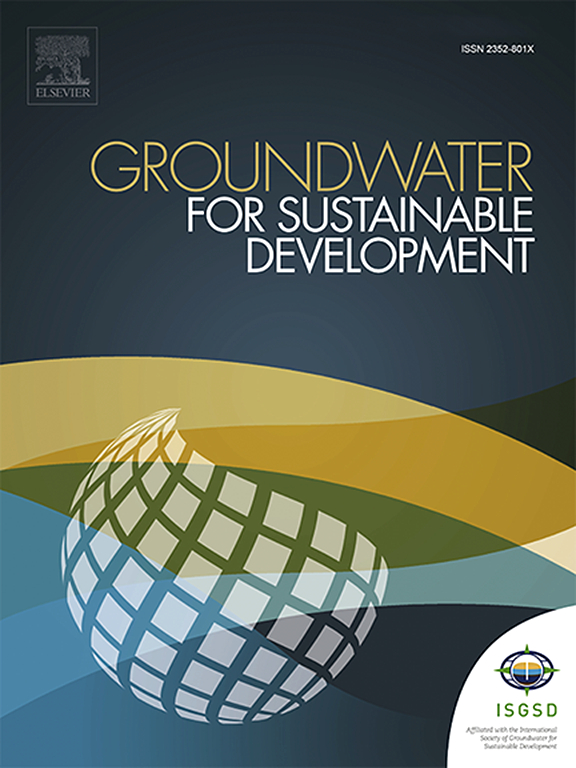通过使用地表水-地下水耦合模型评估环境流量估算的改进
IF 4.9
Q2 ENGINEERING, ENVIRONMENTAL
引用次数: 0
摘要
环境流量是指维持河流生态系统所需的水量。建立确保这些最低流量的方法至关重要,尤其是在高度人类化的地区,如西班牙。包括 SWAT+ 在内的水文模型可用于模拟自然状态下的河流。然而,在地下水驱动的集水区(如塔霍河源头),准确反映地表水与地下水的相互作用至关重要。由于独立模型的局限性,我们使用了新的 SWAT + gwflow 耦合模型,以在溪流响应中适当体现地表水与地下水的相互作用。(1) 基本 SWAT+,(2) SWAT + gwflow 模型的校准方法侧重于调整低流量,使估算环境流量的日流量更加精确。此外,(3) 还在两个上游站点根据日流量模式对独立模型进行了从月到日的分解试验。我们的结果表明,耦合模型在所有统计指标上都优于独立模型,尤其是在低流量方面,作为低流量性能指标的纳什-苏特克利夫对数(LnNSE)对独立模型来说是不够的,因为它低估了模拟流量。这种低估也反映在环境流量值上,与观测值相比,变化范围在-41%到-58%之间。对于基础模型,分解实验显示环境指标有所改善,将其低估程度降低了一半。最后,与观测值相比,SWAT + gwflow 模型对环境流量的拟合效果最好,在大多数情况下,平均变化率为 ±10%,由于更好地反映了地表水与地下水的相互作用,日较低流量也有所改善。本文章由计算机程序翻译,如有差异,请以英文原文为准。

Assessing improvements in environmental flow estimation through the use of a coupled surface-groundwater model
Environmental flow refers to the water required to maintain river ecosystems. Establishing methodologies to ensure these minimum flow rates is essential, particularly in highly anthropized regions, such as Spain. Hydrological models, including SWAT+, are used to simulate rivers in natural regime. However, accurately representing surface-groundwater interactions is crucial in groundwater-driven catchments, such as the Tagus River headwaters. Due to the standalone model limitations, we used the new coupled SWAT + gwflow model to appropriately represent surface-groundwater interactions in streamflow response. The calibration approaches of the (1) base SWAT+, and (2) SWAT + gwflow models focused on adjusting low flows, allowing for greater accuracy in daily flows to estimate environmental flows. In addition, (3) an experiment of monthly-to-daily disaggregation of the standalone model based on a daily flow pattern was conducted at two upstream stations. Our results indicated that the coupled model outperformed the standalone model across all statistical indicators, especially in low flows, where the Nash-Sutcliffe logarithm (LnNSE), an indicator of low flow performance, was inadequate for the standalone model because it underestimated of the simulated flows. This underestimation was also reflected in the environmental flow values, with variations ranging between −41% and −58% compared to the observed values. For the base model, a disaggregation experiment showed an improvement in environmental indicators, reducing their underestimation by half. Finally, the SWAT + gwflow model showed the best fit for environmental flows compared to observations, with average variations of ±10% in most cases, showing improvement in daily low flows due to a better representation of surface-groundwater interactions.
求助全文
通过发布文献求助,成功后即可免费获取论文全文。
去求助
来源期刊

Groundwater for Sustainable Development
Social Sciences-Geography, Planning and Development
CiteScore
11.50
自引率
10.20%
发文量
152
期刊介绍:
Groundwater for Sustainable Development is directed to different stakeholders and professionals, including government and non-governmental organizations, international funding agencies, universities, public water institutions, public health and other public/private sector professionals, and other relevant institutions. It is aimed at professionals, academics and students in the fields of disciplines such as: groundwater and its connection to surface hydrology and environment, soil sciences, engineering, ecology, microbiology, atmospheric sciences, analytical chemistry, hydro-engineering, water technology, environmental ethics, economics, public health, policy, as well as social sciences, legal disciplines, or any other area connected with water issues. The objectives of this journal are to facilitate: • The improvement of effective and sustainable management of water resources across the globe. • The improvement of human access to groundwater resources in adequate quantity and good quality. • The meeting of the increasing demand for drinking and irrigation water needed for food security to contribute to a social and economically sound human development. • The creation of a global inter- and multidisciplinary platform and forum to improve our understanding of groundwater resources and to advocate their effective and sustainable management and protection against contamination. • Interdisciplinary information exchange and to stimulate scientific research in the fields of groundwater related sciences and social and health sciences required to achieve the United Nations Millennium Development Goals for sustainable development.
 求助内容:
求助内容: 应助结果提醒方式:
应助结果提醒方式:


